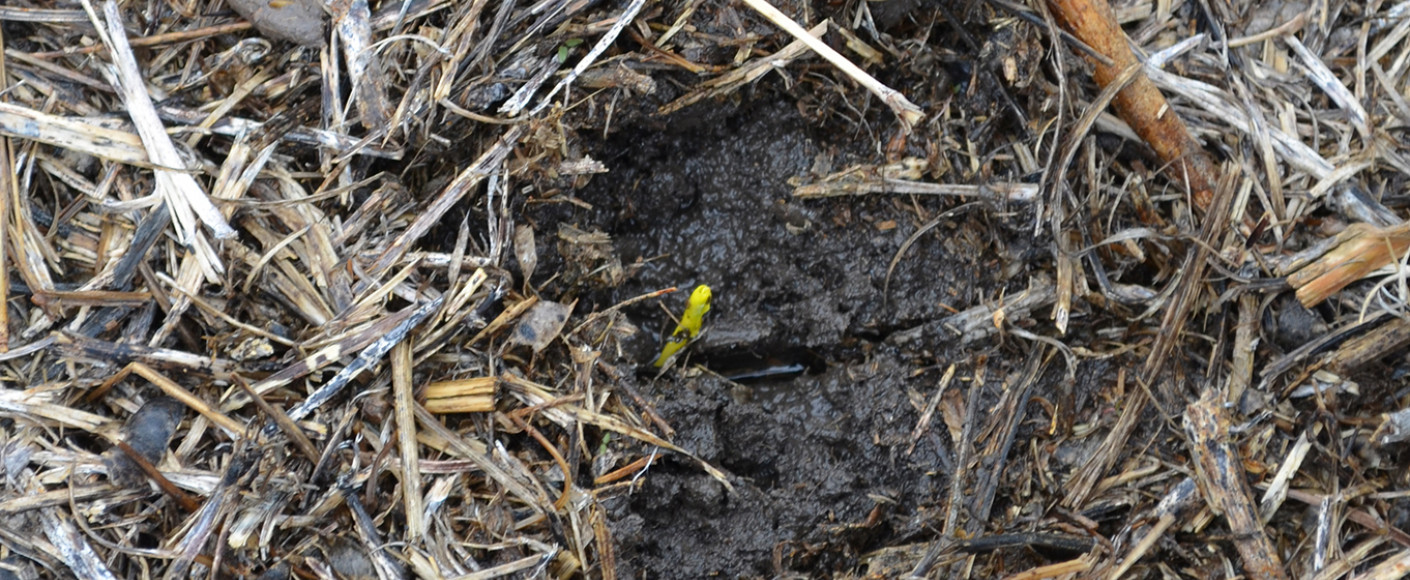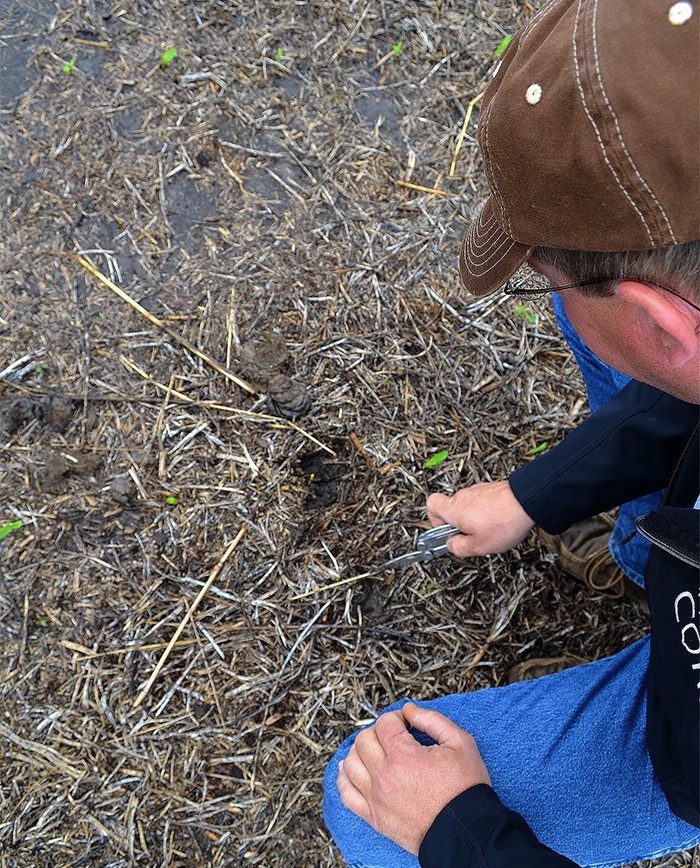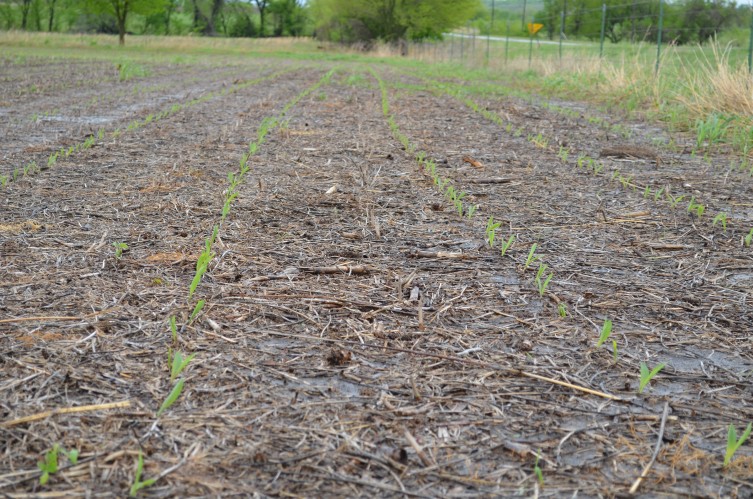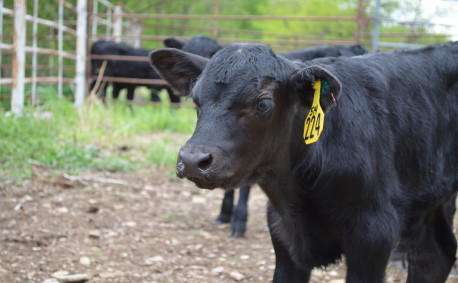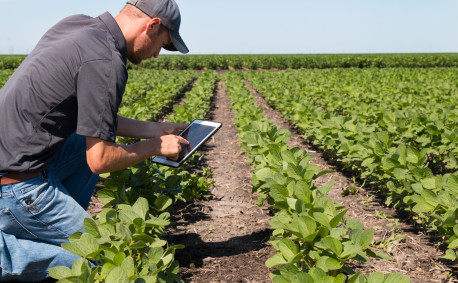Sustainability on the Small Farm
"There should be a plant right here."
Randy Small of 2S Land and Cattle in Neodesha kneels down by the edge of a cornfield and points to a small spot between two little sprouts. It looks like another evenly spaced row of budding corn plants to me, but he pulls out a pocket tool and gently turns up the soil. Sure enough, there is a tender, yellow-green shoot just beneath the surface.
Perhaps it’s not quite as tender as it looks. After all, an onslaught of rain has left pools of water on fields across the county and this little plant is still here. That’s thanks in large part to the strength of the soil.
“Soil can be strong?” I wonder.
“We couldn’t have walked over here with all this rain if we had tilled the soil,” Randy explains. “We would’ve been up to our shins in mud.”
But we could walk in the field just fine because the integrity of the soil structure remained intact. That’s because the Smalls run a no-till operation. Just like it sounds, that means they don't till, or turn over the soil on their land through plowing. They leave the stalks and leaves from the previous crop on the surface to decay, adding nutrients and structure to the soil.
"We've been 100 percent no-till for 19 years," Randy’s wife Nicole says with pride.
How is that sustainable?
Tilled fields have looser soil, which makes them more susceptible to flooding. Tilling disturbs earthworm channels, which help hold soil together. It also increases the likelihood of soil erosion, especially in lower-elevation land. Plus, tilling requires additional fuel and labor to run the machinery.
This is just one way the Small family focuses on sustainability. And their efforts help them:
- Reduce costs
- Preserve the environment
- Sustain the industry
Conservation and the Bottom Line: Cost Reduction
There’s a real cost benefit to going green on the farm. By not tilling their farmland, the Smalls see a savings in their business operation. On top of reduced fuel consumption and labor savings, no-till crops require less fertilizer. That’s because soil that isn’t tilled has better nutrient retention and cycling. So, the Smalls fertilize only when absolutely necessary and in phases to prevent excess runoff—yet another savings for their business and the environment.
Environmental Sustainability: Preserving the Land
Protecting the environment is perhaps the most crucial component of sustainability on the farm. The land gives life—to crops, cattle, and native plants. Plus, it serves as a habitat for wildlife. If the land suffers, everyone suffers.
In addition to not tilling their fields, the Smalls also plant relay crops. That means when one crop is growing, they plant a second crop into the same field before the first crop is harvested. Relay cropping can help boost nutrients in the soil.
To help preserve the native grasses, the Smalls also protect their pastures from overgrazing, conduct controlled burning, and limit their use of herbicides. (Many farmers use herbicide sparingly. In fact, most people put more chemicals on their home lawns than farmers do on an entire acre of land!)
After years of a declining quail population, the Smalls have started to see more on their property.
“You get an economic benefit from managing the native grass, but it also has a lot of meaning for us,” Nicole says. “Farmers truly care about the environment. It’s a precious resource to us and sometimes that message gets lost.”
Stewards of the Land: Continuity for Farms and Families
When it comes to sustainability on the farm, one aspect that often gets overlooked is that of the farming lifestyle. About 40 percent of the population in the U.S. used to farm. Now that number is down to about two percent. The world desperately needs farmers to feed the booming population. But each generation sees fewer families returning to the business.
In addition to farming and ranching their own land, the Smalls also lease land from families who no longer farm but still own property in the area.
"We feel it's a privilege to take care of their family's heritage," Nicole says.
And the connection is personal—the Smalls themselves are a sixth-generation farming family. Randy and Nicole farm the same fields, owned as well as leased, that their grandparents once farmed.
They are committed to caring for the land. Randy calls this the “farming work ethic.”
“We take the time to do things the right way, now,” he explains. “And we continue to learn so we can be more effective and efficient.”
And their commitment has paid off. The Smalls' operation was recognized with the Leopold Conservation Award in 2016.
As for that budding corn plant, it isn't out of the woods yet. There are still more spring showers to come. But thanks to their sustainability measures and environmental stewardship, it—and the entire farm—stands a fighting chance.
To learn more about the Small family and their farming and ranching operation, check out their profile.

